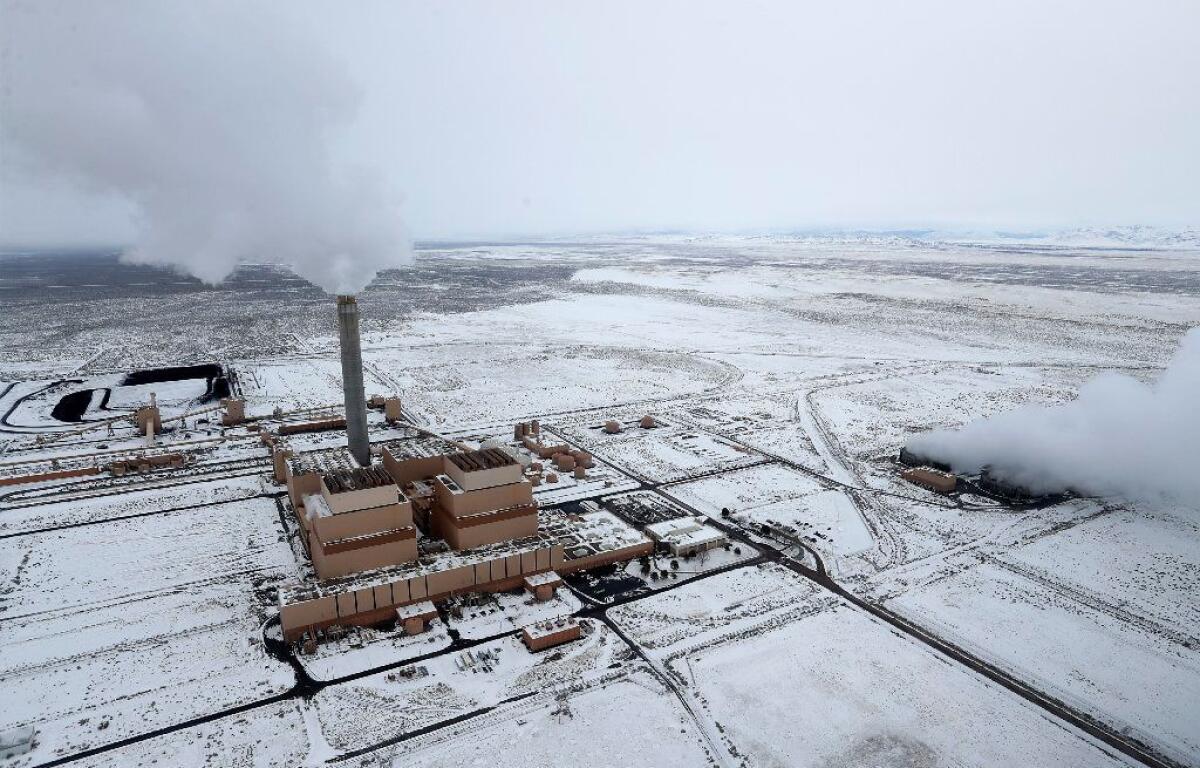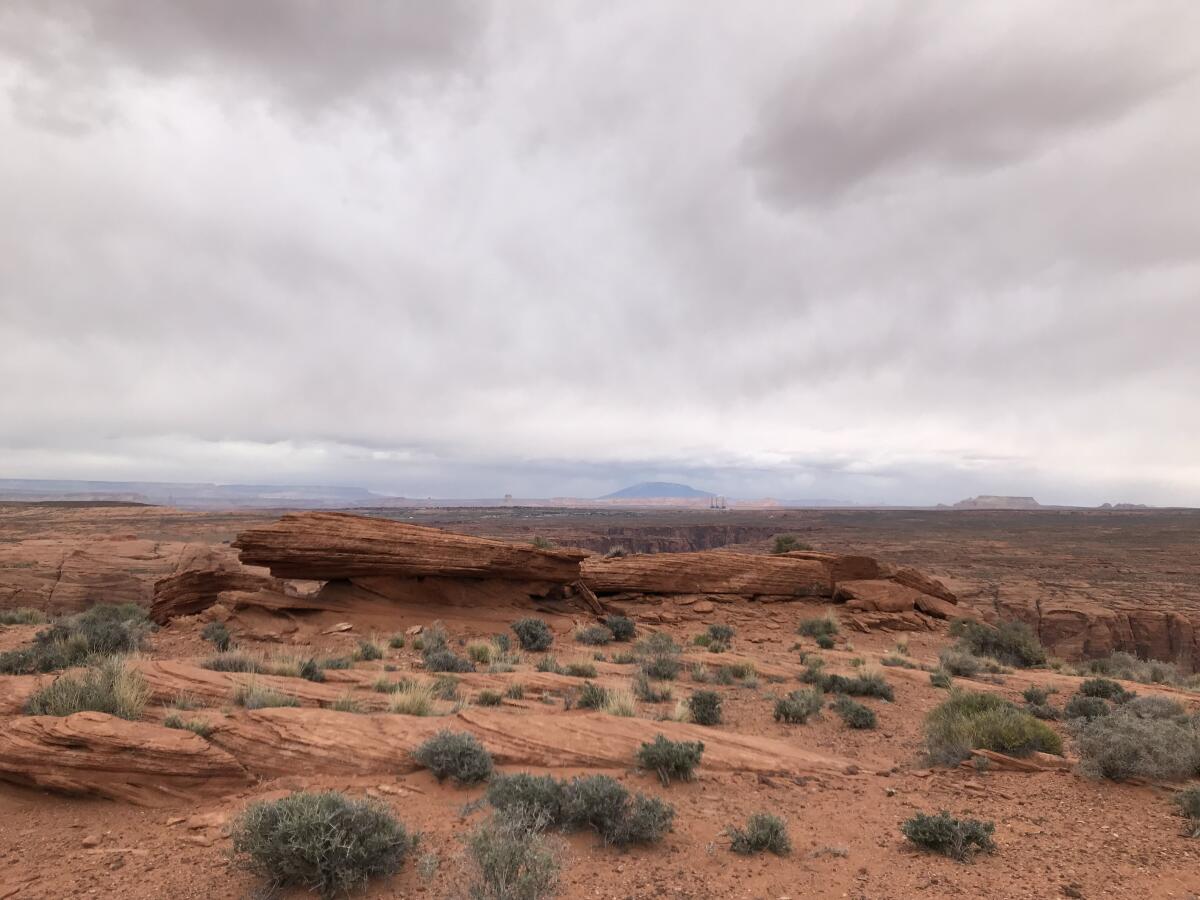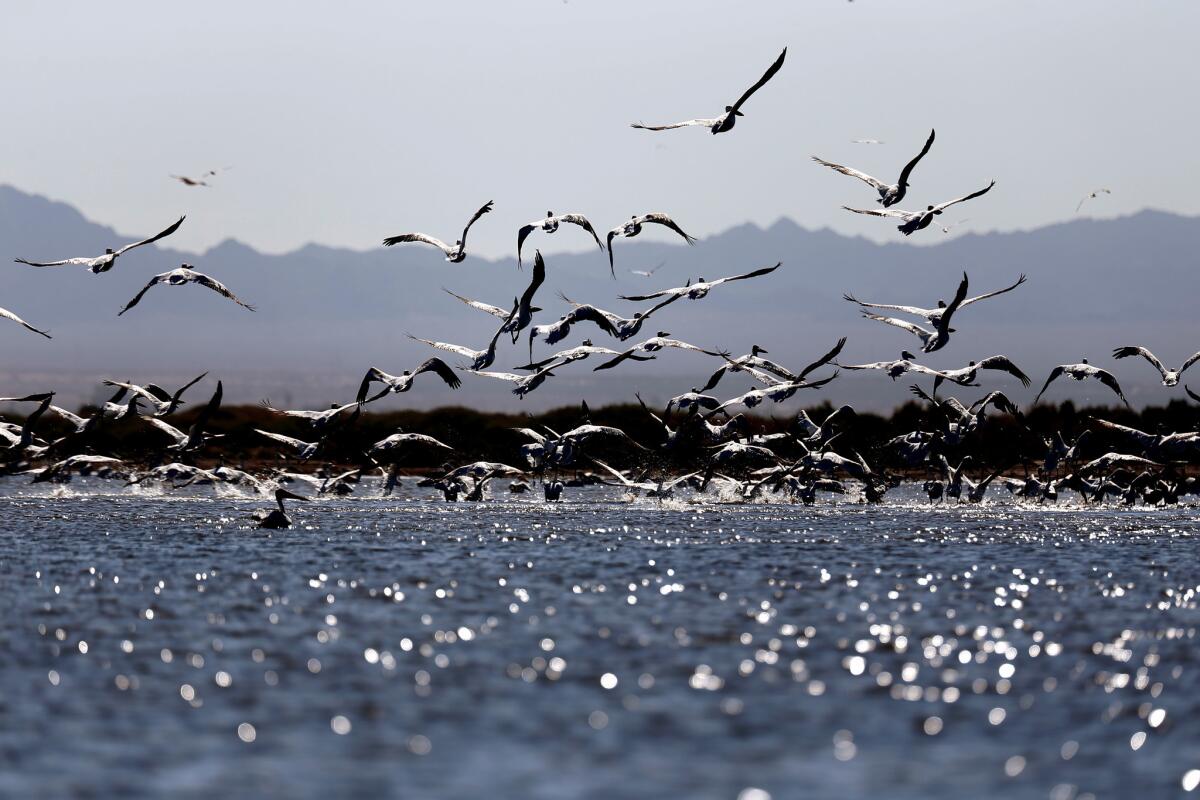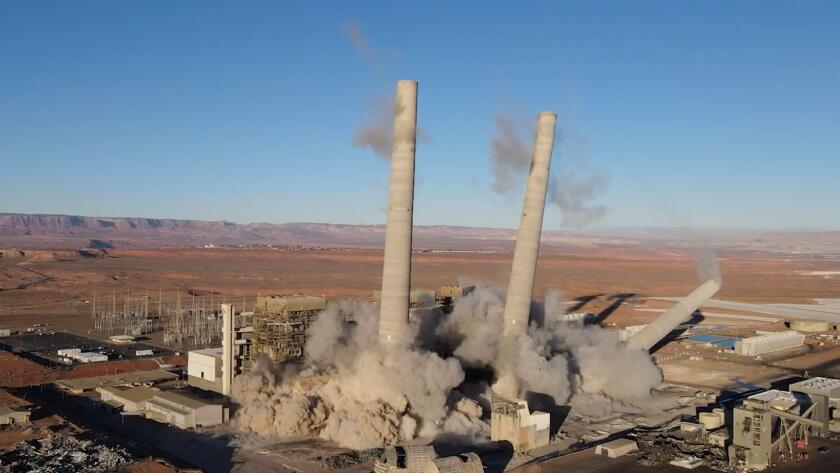Boiling Point: The coal industry comes tumbling down in the American West
- Share via
This is the Dec. 24, 2020, edition of Boiling Point, a weekly newsletter about climate change and the environment in California and the American West. Sign up here to get it in your inbox.
Navajo Generating Station, built half a century ago along the Colorado River near the Arizona-Utah state line, was the largest coal-fired power plant in the American West. It generated huge amounts of electricity for Los Angeles and powered the pumps that carry Colorado River water uphill to Phoenix, helping the desert city become a thriving metropolis. Its three 775-foot smokestacks towered over a gorgeous red rock landscape, belching planet-warming carbon dioxide and lung-damaging chemicals.
On Friday, demolition crews toppled the smokestacks with a series of thundering booms.
Here’s a video of the detonations that felled the once-might towers, courtesy of EcoFlight:
- Share via
Video by EcoFlight / Jonathan Kloberdanz
Navajo Generating Station stopped producing power last year, out-competed by cheaper electricity sources. The Arizona Republic’s Ryan Randazzo wrote about the smokestacks coming down, noting that the coal plant and associated mine once employed hundreds of workers, most of them Indigenous, while also fouling the air breathed by the Navajo and Hopi peoples.
“I’m relieved,” Hopi environmental activist Howard Dennis told Randazzo. “It’s been a struggle for a long time.”
Toward a more sustainable California
Get Boiling Point, our newsletter exploring climate change, energy and the environment, and become part of the conversation — and the solution.
You may occasionally receive promotional content from the Los Angeles Times.
The demolition capped off another tumultuous year for coal power. The industry helped build the modern West, but it’s collapsing as utility companies turn to natural gas, solar panels and wind turbines for lower-cost electricity, and as voters demand cleaner energy to reduce air pollution and confront the climate crisis.
After an eventful January that saw several western utilities pledge to move away from the dirtiest fossil fuel, I wrote that there were just 20 coal-fired generators left in the region without firm retirement dates. The list got shorter in June, when Colorado’s Platte River Power Authority pledged to shutter its Rawhide coal plant by 2030. Ten days later, the city of Colorado Springs decided to close one coal plant in 2023 and another by 2030.
New Mexico’s Escalante Generating Station produced its final coal-fired electrons in August, and Portland General Electric shut down Oregon’s last coal plant in October. Those facilities will be joined in retirement in the next few days by one of two units at Washington’s Centralia coal plant and one of four units at Arizona’s Cholla coal plant. PacifiCorp, a subsidiary of Warren Buffett’s Berkshire Hathaway empire, expects its Cholla unit to come offline around noon today, Christmas Eve.
Also in Arizona, officials approved new rules last month requiring utilities to achieve 100% carbon-free electricity by 2050. That spells trouble for the state’s two remaining coal plants without retirement dates, although coal supporters remain hopeful that carbon-capture technologies being tested in Wyoming might eventually offer the industry a lifeline.
There were also some fascinating developments at Utah’s Intermountain Power Plant, which is operated by the Los Angeles Department of Water and Power and generates about one-fifth of L.A.’s electricity — yes, from burning coal.

Intermountain is the last coal plant serving California, and it’s scheduled to shut down in 2025. I wrote last year about L.A.’s plan to replace the facility with a natural gas-fired plant that can eventually run on renewable hydrogen rather than gas — something that’s never been done before and isn’t guaranteed to work out.
Laura Nelson is hopeful. A former energy adviser to Utah Gov. Gary Herbert, Nelson was hired earlier this year to run the Green Hydrogen Coalition, a new nonprofit formed to support the Intermountain conversion and other initiatives. She sees the Intermountain site as a potential hub for a western hydrogen industry, in part because of the unique potential to store the clean fuel in naturally occurring underground salt caverns that happen to be located across the street from the coal plant.
In March, Intermountain Power Agency contracted with Mitsubishi Hitachi Power Systems to provide turbines that will initially run on a mixture of 30% hydrogen and 70% gas, with plans to ramp up to 100% hydrogen by 2045. Over the summer, the agency issued a request for proposals seeking companies that can produce hydrogen using renewable energy, most likely through a process known as electrolysis, in which water molecules are split into hydrogen and oxygen atoms.
It’s not just Los Angeles that stands to benefit. Arizona, Nevada, New Mexico and Washington have followed California’s lead in adopting 100% clean energy goals. In Utah, Salt Lake and 22 other cities and counties are targeting 100% clean energy by 2030. In Wyoming — home to a bunch of coal plants with no retirement dates — several cities are pushing to reduce emissions.
“We’ve come a long way in terms of how things are transitioning,” Nelson told me.
In Montana, the coal-burning Lewis and Clark station will make its final curtain call in March. Nevada’s major electric utility plans to close half of the state’s largest remaining coal plant next year; the other half could shut down as soon as 2022 following Idaho Power’s recent announcement that it hopes to exit the facility three years ahead of schedule. New Mexico’s San Juan Generating Station will shutter in 2022, with state regulators approving a plan this summer to replace its output with renewable power.
Even some of the western coal plants without firm retirement dates may not be long for this world.
Xcel Energy hasn’t set a deadline for closing three Colorado facilities, but the company has pledged to cut emissions 80% by 2030 and 100% by 2050, meaning a transition away from coal is almost certainly on the horizon. Then there’s the massive Colstrip plant in Montana. Its ability to operate past 2025 was recently thrown into question, when Puget Sound Energy’s agreement to sell part of its stake in the facility for $1 fell apart after Washington state regulators suggested they might reject the unusual deal.
Like I said, it’s been a tumultuous year for coal.
I never got a chance to visit Navajo Generating Station. But I did see it from a distance last year. While exploring Lees Ferry, the historic dividing point between the Colorado River’s upper and lower basins, I hiked to the top of a red rock plateau and looked north, spying the 775-foot smokestacks as tiny columns in the distance:

The demolition of those stacks can’t undo the decades of mercury, arsenic and sulfur dioxide they spewed into the air, or the carbon they launched into the atmosphere, which will remain there for centuries, heating the planet.
But this Christmas and every holiday season from now on, westerners will have a bit less coal in their stockings.
And now, here’s what else is happening around the West:
TOP STORIES
Let’s start with one of the most insane investigations I’ve ever read. My L.A. Times colleague Kiera Feldman discovered that it’s disturbingly common for toxic gases from airplane jet engines to leak into a plane’s air supply, potentially leading to long-term health consequences for passengers and crew. The industry has known about this problem for decades and refused to install air sensors due to fear of litigation, despite some incidents in which pilots have become so incapacitated they’re barely able to fly.
Joe Biden chose Deb Haaland, a congresswoman from New Mexico, to lead the Interior Department. If confirmed, she’ll be the first-ever Native American Cabinet member, as The Times’ Anna M. Phillips reports, and she’ll play a key role in Biden’s plan to end oil and gas leasing on public lands. Indian Country Today wrote that Native people “are crying happy tears” after four years of federal policies that harmed Indigenous communities, a topic Anna V. Smith explored this week for High Country News.
Biden filled out the rest of his climate team, selecting North Carolina official Michael Regan to lead the Environmental Protection Agency and former federal official Brenda Mallory to run the Council on Environmental Quality. Nowhere to be found? Mary Nichols, an influential California regulator seen as a leading candidate for EPA. Her chances were felled by activists who say Nichols didn’t do enough to reduce pollution in low-income areas and communities of color, Anna M. Phillips reports.
California is finally suing to recover cleanup costs from companies connected to the shuttered Exide Technologies battery recycling plant in Vernon, which spread huge amounts of lead pollution across a working-class Latino neighborhood. But the lawsuit is coming so late that Exide itself has already escaped additional liability through bankruptcy, and any funds eventually recovered from other companies won’t speed up the cleanup process anytime soon, The Times’ Tony Barboza reports.
CALIFORNIA BURNING
California and the federal government spend billions fighting fires while doing little to fund projects they know are needed to prevent fires. My colleague Bettina Boxall explored the reasons why that might be, including institutional incentives that value firefighting over prevention. Joseph Serna, meanwhile, wrote about how worsening infernos driven in part by climate change are permanently altering California’s iconic forests, some of which might become entirely different types of landscapes.
Dangerous fire conditions are back Christmas week as drought blankets the West. The Times’ Paul Duginski reports that Las Vegas just had its driest six-month period on record, with no measurable rainfall, and that Los Angeles is warm and dry following the hottest November on record globally. As I write this newsletter, on Wednesday afternoon, Southern California Edison has shut off electricity to nearly 18,000 customers in an effort to prevent ignitions, and is warning 163,000 more that they could lose power.
In some places, wildfires could spread toxic chemicals from Superfund sites. It’s come close to happening in California and Montana, and it seems like only a matter of time before disaster strikes somewhere, as Michael Kodas and David Hasemyer report in an important investigation for Inside Climate News, NBC News and the Texas Observer. Also, new research suggests that fires could be causing plastic pipes to leach contaminants into water supplies, Circle of Blue’s Brett Walton reports.
AROUND THE WEST

When I lived in Palm Springs, I reported frequently on the Salton Sea, an oasis for birds that is releasing hazardous dust into the air breathed by poor, largely Latino communities as it dries up. I was frustrated to read this latest update from Mark Olalde for the Desert Sun and High Country News, about a state-led restoration process that continues to be agonizingly slow.
At a conference several years ago, I was lucky enough to spend some time with Ryan Sabalow, an environmental reporter for the Sacramento Bee. He cares deeply about the rural northeastern corner of California where he grew up, so I was thrilled to learn that he’s written a series of stories about ecological crises afflicting this often-overlooked part of the state, and what they might mean for the wider West. Part 1 deals with wild horses, and Part 2 with the conflict between wolves and ranchers.
In the dying days of the Trump administration, federal officials are rushing to greenlight energy and mining projects on public lands in the West. The New York Times’ Eric Lipton took a deep dive into several of those projects, including an Arizona copper mine that would destroy a landscape sacred to Native Americans, helium drilling in a newly designated wilderness area in Utah, and a uranium mine near South Dakota’s Black Hills that the Oglala Lakota Nation says would be built on stolen land.
The coronavirus relief and government funding bill approved by Congress would restore healthcare benefits to Marshall Islands residents living in the U.S. The federal government offered medical care to the Marshallese after conducting dozens of nuclear tests in and around the islands, but accidentally revoked those benefits in 1996 and for 24 years refused to reinstate them, The Times’ Susanne Rust reports. As you may have heard, through, President Trump might not sign the relief bill.
THE ENERGY TRANSITION
Speaking of the government funding bill, it would also be the most significant climate legislation in a decade. Energy journalist David Roberts, who recently started a newsletter called Volts, explains why: $35 billion in research and development funding for renewables, carbon capture and clean grid technologies; an extension of tax credits for solar and wind power; and a commitment to phase down the use of planet-warming chemicals known as HFCs, among other stuff. The bill also includes a national target of building 25 gigawatts of renewable energy on public lands; I’ve written previously about the opportunities and challenges here.
San Diego’s new mayor rejected a bid by San Diego Gas & Electric to continue as the city’s exclusive gas and electric utility. Here’s the story from the San Diego Union-Tribune’s Rob Nikolewski. The rapidly approaching expiration of SDG&E’s longtime franchise agreement with the city sent elected officials scrambling to drum up competition. SDG&E was ultimately the only company to make an offer, but Mayor Todd Gloria still hopes to strike a more favorable deal with the Sempra Energy subsidiary.
Elon Musk says he tried to get Apple to buy Tesla several years ago, during the “darkest days” of the carmaker’s troubled Model 3 rollout. Here’s the story from my colleague Russ Mitchell, who notes that Tesla’s market value is now a cool $640 billion.
ONE MORE THING
If you love the outdoors or want to motivate yourself to spend more time outside, I’d highly recommending signing up for The Wild, another excellent L.A. Times newsletter written by Mary Forgione. I’ve very much enjoyed her hiking suggestions!
We’ll be back in your inbox next week. If you enjoyed this newsletter, please consider forwarding it to your friends and colleagues.





